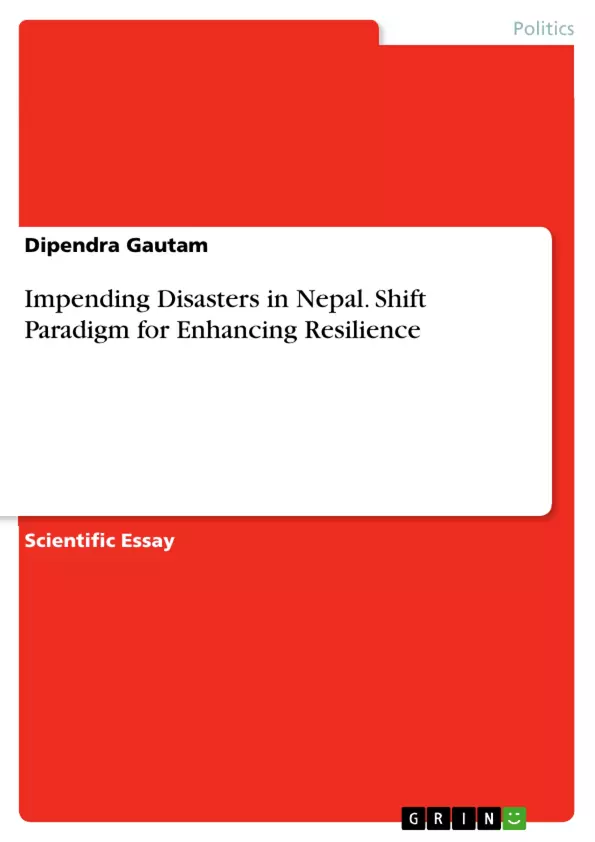Global understanding of disaster has been striding into the paradigm shift from response to relief to disaster risk reduction as every year more than 200 million people live under the impact of various types of disaster events; precisely, disasters are those events which strike over the normalcy of life. Although Nepal has increasingly surpassed the rest of the world in disaster vulnerability, lackadaisical planning has marred the catastrophic response with reference to manpower, money and machines, leading in the greater claim in very events either natural or human induced. Exposure to such events has now shifted to glocal panorama; participating from global warming to haphazard settlement growth, over-claiming the natural resources, squabbling infrastructure built-ups among others. Traumatic experiences of past events have still beseeched the planners, often guided with the response and relief framework formulation; could switch the paradigm shift towards disaster risk reduction. To the surprise of many disaster managers, this contingency planning is densely forbidding; highlighting the strategy of post disaster response and shadowing the pre-disaster initiatives before the impending catastrophes jolt entire nation exceeding our capabilities. Mushroomed growth of population, rapid and haphazard urbanization, alarming environmental degradation, global warming, overexploitation of natural resources and poor strategy of coping have even triggered the vulnerability and susceptibility of disaster events in Nepal, worsening the infrastructures and livelihood.
Inhaltsverzeichnis (Table of Contents)
- Impending Disasters in Nepal
- Misconception and Hysteria
- Disaster Policy and the Women, Poor and the Excluded (WPE)
- Contingency Planning
- Resolution
Zielsetzung und Themenschwerpunkte (Objectives and Key Themes)
This article examines the impending disaster risks facing Nepal and advocates for a shift in paradigm from disaster response and relief to disaster risk reduction. It explores the country's vulnerability to various disaster events, particularly in the context of rapid urbanization, environmental degradation, and global warming. The article also emphasizes the need for inclusive policies that address the specific needs of marginalized communities.
- Disaster Vulnerability in Nepal
- The Need for Disaster Risk Reduction
- The Role of Local Knowledge and Traditional Coping Mechanisms
- The Importance of Inclusive Disaster Policies
- Resilience Building in Communities
Zusammenfassung der Kapitel (Chapter Summaries)
- The article begins by outlining the growing disaster vulnerability of Nepal, highlighting how past events have revealed the inadequacies of current disaster response and relief strategies. It emphasizes the urgent need for a shift towards disaster risk reduction to mitigate the impact of future events.
- The article then addresses the misconception that earthquakes are the only significant disaster threat in Nepal. It argues that a broader understanding of disaster risks is crucial, encompassing epidemics, landslides, and other events that can be exacerbated by climate change and human activities.
- The article highlights the vulnerability of marginalized communities in Nepal to disaster events. It emphasizes the need for inclusive disaster policies that recognize and address the specific needs of women, the poor, and the excluded.
- The article examines the limitations of current disaster planning, particularly the focus on response and relief. It advocates for a shift towards integrated disaster risk reduction, incorporating local knowledge and community-based approaches.
- The article concludes by emphasizing the importance of local knowledge, community participation, and structural preparedness in enhancing Nepal's resilience to disasters. It advocates for a shift in focus from response and relief to proactive disaster risk management, emphasizing the need for a more holistic and inclusive approach.
Schlüsselwörter (Keywords)
Disaster risk reduction, vulnerability, resilience, inclusive policies, local knowledge, traditional coping mechanisms, marginalized communities, women, poor, excluded, Nepal, disaster preparedness, climate change, global warming, urbanization, environmental degradation, disaster response, relief, contingency planning, integrated disaster management.
- Quote paper
- Dipendra Gautam (Author), 2014, Impending Disasters in Nepal. Shift Paradigm for Enhancing Resilience, Munich, GRIN Verlag, https://www.grin.com/document/278753



